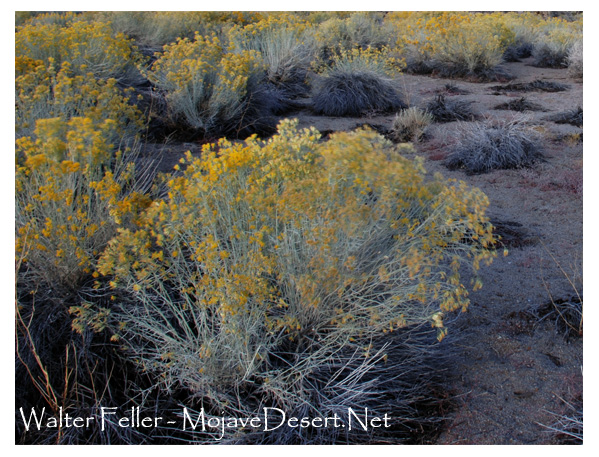Rabbitbrush
Chrysothamnus viscidiflorus
Rabbitbrush in the Mojave Desert: A Survivor
Rabbitbrush, particularly the species Chrysothamnus viscidiflorus, stands as a testament to the adaptability of desert flora. In the harsh environment of the Mojave Desert, this hardy shrub plays a crucial role in the ecosystem, contributing to biodiversity, soil stability, and providing resources for wildlife.General Characteristics and Distribution
Rabbitbrush is widely distributed across western North America, with its range extending from British Columbia down to southeastern California and eastward to North Dakota, Arizona, New Mexico, and Texas. In the Mojave Desert, it thrives despite the challenging conditions, marked by extreme temperatures, low precipitation, and poor soil quality. Its distinctive bright yellow flowers are a familiar sight, bringing color and life to the arid landscape.Adaptations to Desert Life
The success of rabbitbrush in the Mojave Desert can be attributed to several adaptations. Firstly, its deep root system allows it to access water stored deep underground, an essential trait in an environment where surface water is scarce. This root system also helps stabilize the soil, preventing erosion and promoting soil health. The shrub's small, narrow leaves reduce water loss through transpiration, an important feature given the desert's high temperatures and intense sunlight.Rabbitbrush's ability to thrive in poor soil conditions is another key to its survival. It is often found in areas with saline or alkaline soils, where few other plants can survive. This adaptability allows it to colonize disturbed sites and poor soils, making it a pioneer species that can pave the way for other vegetation.
Ecological Importance
In the Mojave Desert, rabbitbrush forms part of a complex plant community that includes species like big sagebrush (Artemisia tridentata), snakeweed (Gutierrezia spp.), and other rabbitbrush species. This community is vital for maintaining the ecological balance of the region. Rabbitbrush provides habitat and food for a variety of wildlife. Its flowers attract pollinators such as bees, butterflies, and other insects, which are crucial for the pollination of many other plant species.Moreover, rabbitbrush serves as a food source for herbivores. In times of scarcity, it provides a vital nutritional resource for animals such as deer and rabbits. The shrub's presence also supports a diverse microbial community in the soil, which in turn enhances soil fertility and promotes the growth of other plant species.
Human Uses and Cultural Significance
Rabbitbrush has been used by indigenous peoples for various purposes. The Paiute and other Native American tribes utilized it for making yellow dye, and its flexible branches were sometimes used in basketry. The plant also had medicinal uses, including as a treatment for colds and respiratory ailments. Today, rabbitbrush is sometimes planted for land reclamation and erosion control due to its hardy nature and soil-stabilizing properties.Challenges and Conservation
Despite its resilience, rabbitbrush faces challenges from human activities and climate change. Habitat destruction due to urbanization, agriculture, and mining can reduce its range and disrupt the delicate desert ecosystem. Climate change poses additional threats, with altered precipitation patterns and increased temperatures potentially affecting its growth and survival.Conservation efforts are essential to protect rabbitbrush and the broader Mojave Desert ecosystem. Preserving natural habitats, promoting sustainable land use practices, and supporting research on desert ecology are critical steps in ensuring the survival of this resilient shrub.